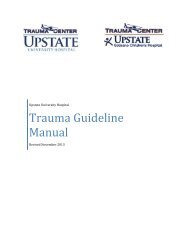2013-2014 Course Selection Book - SUNY Upstate Medical University
2013-2014 Course Selection Book - SUNY Upstate Medical University
2013-2014 Course Selection Book - SUNY Upstate Medical University
- No tags were found...
You also want an ePaper? Increase the reach of your titles
YUMPU automatically turns print PDFs into web optimized ePapers that Google loves.
GENE EXPRESSION AND EPIGENETICREGULATIONB6473 Credit HoursCoordinator(s): Dr. Michael Cosgrove and Dr.Steven Hanes and Biochemistry and MolecularBiology FacultyPeriod Offered:Spring of even years<strong>Course</strong> Description: Directed reading and studentdirected presentations on the primary literaturethat relates to gene expression from transcription tonuclear export. Maximum 12 students.RESEARCH DESIGN IN BIOCHEMISTRY &MOLECULAR BIOLOGYB6483 creditsPrerequisite: General biochemistry and molecularbiology or equivalent and permission of InstructorCoordinator(s):Dr. Xin Jie Chenand Biochemistry & Molecular Biology staffPeriod Offered:Fall/SpringDates, times and location to be arranged by instructor<strong>Course</strong> Description: This course promotes thedevelopment of critical thinking and writingimportant to the students’ future career as scientists.The student will gain experience in designing anoriginal dissertation research project and preparingthe plan in a formal hypothesis-based researchproposal. Students will learn the essential features ofscientific writing, with the emphasis on developingskills necessary for effectively communicatingtheir research design. In the first part of the coursethe essentials of clear, unambiguous scientificwriting will be highlighted through examples andwritten exercises. The elements of good and badscientific writing will be discussed and comparedin a class setting. In the second part of the course,the important features of research design will becovered, implemented in the writing of a researchgrant-style proposal. The research proposal will bein the student’s area of interest, with help from theInstructor and experts in the field. Students willpublically present their final proposal in an overviewseminar to be arranged at the end of the course.Scheduling: The first month of the course willinitially consist of four 90-minute sessions of theentire class. Subsequent meetings will be on anindividual basis (by arrangement) for approximately1 hour every 2 weeks.<strong>Course</strong> objectives:(1) develop a cogent, hypothesis-based researchproposal that constitutes a “first draft” for theirthesis work as well as a proposal to be submitted forextramural funding.(2) give a clear, compelling oral presentation of theproposal and defend it.Grading: The course will use a satisfactory/unsatisfactory grading format. Grades will be basedon effort and improvement on the exercises andassignments.TOPICS IN QUANTITATIVE BIOLOGY. . . . . . . . . . . . . . . . . . . . . . . B6491 credit (2 hr sessions/every other week)Coordinator(s): Dr. Barry Knox & Dr. Peter CalvertPeriod Offered:Fall, even years<strong>Course</strong> grading: Satisfactory / UnsatisfactoryClass Size:Limited to 12 studentsPart 1. Quantitative Biochemistry (Thermodynamics,physical biochemistry, enzyme kinetics, water).Part 2. Quantitative Cell Biology (Bioimaging,protein-protein interactions in living cells, diffusion).Part 3. Design Principles of Biological Circuits(Network basics, autoregulation, feed-forward loops,robustness, kinetics).This course is a seminar course on how, at a systemslevel, biological molecules interact and cells respondto their environment using quantitative approachesand analysis. Cross disciplinary techniques will beemphasized, to encourage students to think abouttraditional subjects in new ways. The focus will beon the description and use of models to explain howmolecules drive complex phenomenon essentialto cellular functions. The class will include lecture,presentation of original research articles and a finalpaper.15
















